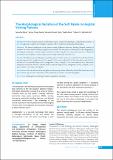Please use this identifier to cite or link to this item:
https://hdl.handle.net/20.500.14356/1050| Title: | The Morphological Variation of the Soft Palate in Hospital Visiting Patients |
| Authors: | Dahal, Samarika Gupta, Sanjay Prasad Singh, Ashutosh Kumar Baral, Radha N, Srikant Giri, Abhishek |
| Citation: | DahalS., GuptaS. P., SinghA. K., BaralR., Srikant N, & GiriA. (2022). The Morphological Variation of the Soft Palate in Hospital Visiting Patients. Journal of Nepal Health Research Council, 20(01), 229-233. https://doi.org/10.33314/jnhrc.v20i01.4044 |
| Issue Date: | 2022 |
| Publisher: | Nepal Health Research Council |
| Article Type: | Original Article |
| Keywords: | Cephalogram morphology Nepalese population soft palate |
| Series/Report no.: | Jan-March, 2022;4044 |
| Abstract: | Abstract Background: The soft palate anatomy of individuals can have a range of morphologies. Cephalometric analysis is a low-cost approach to analyze the soft palate in patients with or without developmental abnormalities. Methods: The lateral cephalogram of the patients visiting Tribhuvan University Teaching Hospital, Institute of Medicine for various dental treatment purposes was evaluated. The soft palate was delineated on the radiographs by sketching the soft palate's contour along its radiolucent outline using the curve lines and connectors of Microsoft PowerPoint. The soft palate was then categorized according to the study by You M et al. Results: The different types of soft palate morphology observed in the study were rat tail (42.4%), leaf-like (40.8%), butt-like shape (8.9%), straight-line (4.7%), s-shaped (1.9%), and crooked (0.9%). The males had rat-tail (44.4%), leaf-like (41.1%), butt-like shape (8.4%), straight-line (3.9%), s-shaped (1.3%), and crooked (0.6%), whereas the females had rat-tail like (40.6%), leaf-like (40.6%), butt-like shape (9.5%), straight-line (5.6%), s-shaped (2.5%), and crooked (1.2%) types of soft palate. Conclusions: The rat-tail form of the soft palate was the most prevalent, followed by the leaf-like in both sexes. The least common type was the crooked form. This study found no evidence of sexual dimorphism. Keywords: Cephalogram; morphology; Nepalese population; soft palate. |
| Description: | Original Article |
| URI: | http://103.69.126.140:8080/handle/20.500.14356/1050 |
| ISSN: | Print ISSN: 1727-5482; Online ISSN: 1999-6217 |
| Appears in Collections: | Vol. 20 No. 01 (2022): Issue 54 Jan-March, 2022 |
Files in This Item:
| File | Description | Size | Format | |
|---|---|---|---|---|
| 4044-Manuscript-27973-1-10-20220609.pdf | Fulltext Download | 323.92 kB | Adobe PDF |  View/Open |
Items in DSpace are protected by copyright, with all rights reserved, unless otherwise indicated.
